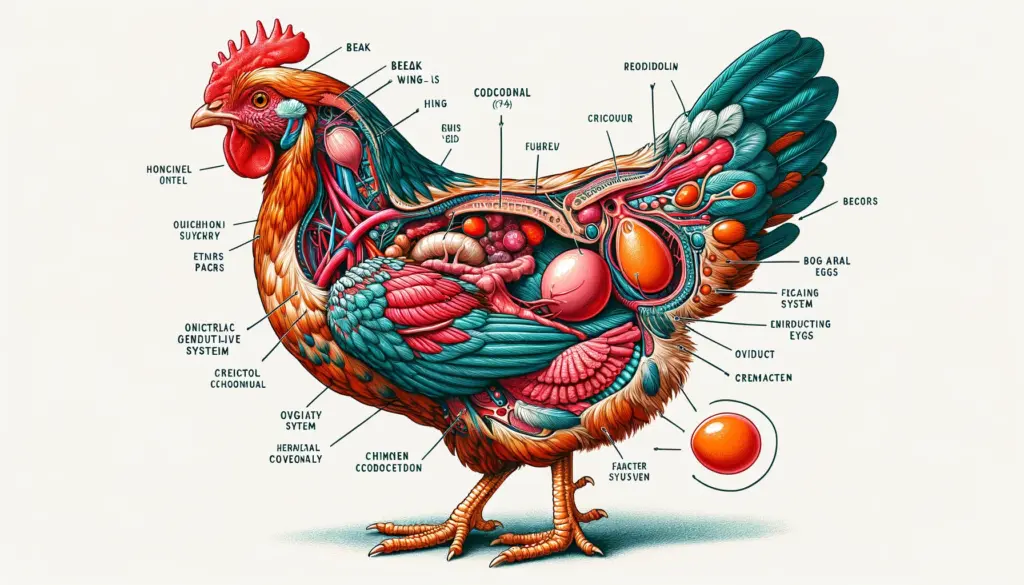Introduction
Chicken eggs come out through a part of the chicken called the cloaca. It’s important to know how this process works, especially if you keep chickens or are interested in where your food comes from.
This guide will teach you everything you need to know about the egg-laying process.
The Egg-Laying Process
Chickens lay eggs in a cycle that takes about 24-26 hours. This process starts with the formation of the yolk in the ovary. The yolk then travels through the oviduct, where the egg white (albumen) and shell are added. Finally, the fully formed egg passes through the cloaca and is laid by the chicken.
- Time to Lay an Egg: The entire process, from the formation of the yolk to laying the egg, takes roughly a day.
- Oviduct: The oviduct is a tube-like structure where the egg develops. It has different parts that add the albumen, membranes, and shell to the yolk.
- Cloaca: The cloaca is the exit point for the egg. It ensures the egg comes out clean by separating the egg-laying process from waste elimination.
Chickens do not need a rooster to lay eggs. However, without a rooster, the eggs will be unfertilized and will not hatch into chicks.
Read More On: What Chicken Lays the Most Eggs
Chicken Anatomy and Reproductive System

Chicken Anatomy
Chickens have a unique anatomy that plays a big role in how they lay eggs. One important part is the cloaca. The cloaca is an opening that serves two purposes: it handles both waste and egg-laying. When a chicken lays an egg, the cloaca shifts to make sure the egg comes out clean and free of contamination.
Another key part of a chicken’s anatomy is the oviduct. The oviduct is a long, coiled tube where the egg forms. This tube is divided into several sections, each with a specific job:
- Infundibulum: This is where the yolk is picked up after it’s released from the ovary.
- Magnum: Here, the egg white (albumen) is added.
- Isthmus: This part adds the inner and outer shell membranes.
- Uterus (or Shell Gland): This is where the shell is formed.
- Vagina: This section holds the egg until it’s ready to be laid.
Reproductive System
The egg formation process starts in the ovary, where yolks develop. Once a yolk is mature, it is released into the infundibulum. The yolk then travels through the different sections of the oviduct, picking up layers of egg white, membranes, and finally, the shell.
As the egg moves through the oviduct:
- Yolk Formation: Yolk is formed in the ovary. This process can take about 10 days.
- Infundibulum: The yolk is picked up here and stays for about 15-30 minutes.
- Magnum: The egg spends about 3 hours here while the egg white is added.
- Isthmus: The egg spends about 1.5 hours here while membranes are added.
- Uterus: The egg stays here for about 20 hours while the shell forms.
- Vagina: The egg moves to the cloaca and is laid.
The entire process from yolk formation to egg-laying takes about 24-26 hours. Chickens typically lay one egg per day.
Table: Stages of Egg Formation
| Stage | Time Spent | Process |
|---|---|---|
| Ovary | ~10 days | Yolk formation |
| Infundibulum | 15-30 minutes | Yolk pickup |
| Magnum | ~3 hours | Addition of egg white (albumen) |
| Isthmus | ~1.5 hours | Addition of inner and outer membranes |
| Uterus | ~20 hours | Shell formation |
| Vagina | Short time | Holding egg before laying |
Understanding chicken anatomy and the egg-laying process is crucial for anyone raising chickens. It helps ensure the chickens are healthy and producing eggs efficiently.
Proper nutrition, a good living environment, and regular health checks are essential for maintaining a productive flock.
Common Misconceptions
Do Chickens Lay Eggs Out of Their Buttholes?
One common misconception is that chickens lay eggs out of their buttholes. This is not true. Chickens lay eggs through an opening called the cloaca. The cloaca serves both as the exit for eggs and waste but functions in a way that keeps the processes separate.
When a chicken lays an egg, the cloaca stretches and inverts slightly, ensuring the egg doesn’t come into contact with waste. This separation is crucial for keeping the egg clean and safe to eat.
Clarification:
- Eggs vs. Waste: The cloaca handles both, but not at the same time. When it’s time to lay an egg, the cloaca ensures the egg comes out clean.
- Clean Process: Chickens have a natural mechanism to keep their eggs from getting contaminated.
Factors Affecting Egg Laying

Several factors can influence how often and how well chickens lay eggs. Understanding these factors can help you keep your hens healthy and productive.
Diet and Nutrition
Chickens need a balanced diet rich in nutrients to lay eggs regularly. Calcium is particularly important for strong eggshells. Providing your hens with a mix of grains, vegetables, and calcium supplements can improve their egg production.
Environment and Light
The living environment of chickens plays a big role in egg laying. Chickens need a calm, stress-free environment. Stress can significantly reduce egg production. Also, light exposure is crucial. Chickens need about 14-16 hours of light each day to lay eggs consistently. During winter, you might need to provide extra light to keep up egg production.
Health and Age
A chicken’s health and age are important factors in egg laying. Younger hens typically lay more eggs than older ones. Regular health checks and vaccinations can help prevent diseases that might affect egg laying.
By paying attention to these factors, you can ensure your chickens are healthy and productive, leading to a steady supply of eggs.
Faq Section
A chicken lays an egg by passing it through the oviduct, where the egg develops in stages. First, the yolk is released from the ovary and captured by the infundibulum. It then moves through the magnum, where the egg white forms. Next, it passes through the isthmus, where the shell membranes are added.
Finally, in the uterus, the shell is formed. The fully developed egg is then pushed through the cloaca, which inverts to prevent contamination with waste. This entire process takes about 24-26 hours.
Laying eggs is a natural process for chickens and is not typically painful. Hens are biologically designed to lay eggs regularly. While it can be uncomfortable at times, especially if the egg is large or the hen is young, it generally doesn’t cause significant pain. Hens might show signs of discomfort or restlessness just before laying, but these are usually short-lived. Providing a comfortable environment with proper nutrition helps minimize any discomfort during egg laying.
Not usually. Chickens lay eggs through the cloaca, which also handles waste elimination. However, the cloaca is designed to minimize contamination. During egg laying, the cloaca inverts, ensuring the egg passes cleanly without touching feces.
Proper hygiene in the coop, such as clean nesting boxes and regular maintenance, further reduces the risk of contamination. Ensuring the chickens have a clean living environment is key to keeping the eggs safe and clean.
The size of chicken eggs is influenced by several factors, including the chicken’s breed, age, and diet. Larger breeds like the Rhode Island Red tend to lay bigger eggs. Younger hens usually lay smaller eggs, which increase in size as they age.
Diet also plays a significant role; hens need a balanced diet rich in protein and calcium to produce larger, healthier eggs. Ensuring hens have adequate nutrition and proper care can help maintain optimal egg size.
No, only hens (female chickens) lay eggs. Roosters (male chickens) do not lay eggs as they lack the reproductive organs needed for egg production. Hens can lay eggs without a rooster, but these eggs will be unfertilized and cannot develop into chicks. Roosters are only needed if you want fertilized eggs for hatching. Understanding the roles of hens and roosters is important for managing a productive flock and ensuring proper care.
It takes about 24-26 hours for a chicken to lay an egg. The process begins with the formation of the yolk in the ovary. The yolk then travels through the oviduct, where it gains layers of egg white, membranes, and finally, the shell. Once the egg is fully formed, it is laid through the cloaca. This cycle means a hen typically lays one egg per day, with slight variations depending on factors like age, breed, and health.
Most chicken eggs are edible, but it’s important to ensure they come from healthy hens. Eggs from sick or unhealthy chickens may not be safe to eat. It’s also crucial to handle and store eggs properly to prevent contamination. Freshness matters, too; older eggs may still be edible but might not taste as good.
Regularly checking the health of your flock and maintaining clean, safe conditions in the coop can help ensure the eggs you collect are safe and tasty.
Yes, chickens can lay eggs in various colors, including white, brown, blue, and green, depending on their breed. For example, Leghorns typically lay white eggs, while Rhode Island Reds lay brown eggs.
Ameraucanas and Araucanas can lay blue or green eggs. The color of an egg doesn’t affect its taste or nutritional value; it’s purely a genetic trait. Providing a mix of breeds can give you a colorful variety of eggs in your egg basket.
Chickens typically start laying eggs around 5-6 months of age. This can vary slightly depending on the breed and individual bird. Lighter breeds like Leghorns often start laying earlier, while heavier breeds like Orpingtons might take a bit longer. Ensuring that young hens receive proper nutrition and care can help them begin laying eggs on time. Once they start, hens generally lay eggs consistently, with the highest production occurring in the first two years.
Egg binding occurs when a hen is unable to lay an egg, which can be life-threatening if not treated promptly. Symptoms include lethargy, straining, and a lack of appetite. Treatment involves providing warmth, hydration, and gentle massage. Sometimes, a vet may need to intervene.
Preventing egg binding involves ensuring hens have a diet rich in calcium and keeping them in a stress-free environment. Regular health checks can also help catch and address this issue early.
Final Thoughts: Where do Chickens eggs come out
In conclusion, chicken eggs come out through the cloaca, not the butthole. Understanding the egg-laying process helps in providing better care for chickens and ensures healthy egg production. This guide has covered the egg-laying process, chicken anatomy, common misconceptions, factors affecting egg laying, and answered related questions. Appreciate the complexity of chicken egg-laying and proper care for hens.

